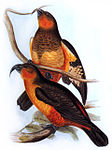| Nestorini
|
Common name
(binomial name)
status
|
Image
|
Description
|
Range and habitat
|
Kea
(Nestor notabilis)
Vulnerable[1]
|

|
48 cm (19 in) long. Mostly olive-green with scarlet underwings and rump. Dark-edged feathers. Dark brown beak, iris, legs, and feet. Male has longer bill.[2]
|
New Zealand: South Island
High-level forests and subalpine scrublands 850–1400 m AMSL.[3]
|
South Island Kaka
(Nestor meridionalis meridionalis)
Endangered[4]
|

|
Similar to the North Island Kaka, but slightly smaller, brighter colours, the crown is almost white, and the bill is longer and more arched in males.[5]
|
New Zealand: South Island
Unbroken tracts of Nothofagus and Podocarpus forests 450–850 m AMSL in summer and 0–550 m in winter.[3]
|
North Island Kaka
(Nestor meridionalis septentrionalis)
Endangered[4]
|

|
About 45 cm (18 in) long. Mainly olive-brown with dark feather edges. Crimson underwings, rump, and collar. The cheeks are golden/brown. The crown is greyish.[5]
|
New Zealand: North Island
Unbroken tracts of Nothofagus and Podocarpus forests between 450–850 m AMSL in summer and 0–550 m in winter.[3]
|
Norfolk Kaka
(Nestor productus)
Extinct by 1851 approx.[6]
|

|
About 38 cm long. Mostly olive-brown upperparts, (reddish-)orange cheeks and throat, straw-coloured breast, thighs, rump and lower abdomen dark orange.[7]
|
Formerly endemic on Norfolk Island and Phillip Island of Australia[8]
Rocks and trees[7]
|
Chatham Kaka
(Nestor sp.)
Extinct by 1550–1700[9]
|
Appearance unknown, but bones indicate reduced flight capability.
|
Only known from subfossil bones.[9]
|
Formerly endemic on Chatham Island of New Zealand
Forests[9]
|